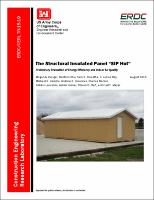Please use this identifier to cite or link to this item:
https://hdl.handle.net/11681/19954| Title: | The Structural Insulated Panel “SIP Hut” : preliminary evaluation of energy efficiency and indoor air quality |
| Authors: | Oak Ridge National Laboratory United States Military Academy. Department of Civil and Mechanical Engineering United States. Office of the Assistant Secretary of the Army for Acquisition, Logistics, and Technology U.S. Army Natick Soldier Research Development & Engineering Center Kreiger, Megan A. Shrestha, Som S. Hay, K. James Kemme, Michael R. Johannes, Andrew C. Decker, Charles T. Lawrence, Debbie J. Kumar, A. (Ashok), 1938- Hart, Steven D. Meyer, Karl F. Chu, Dahtzen |
| Keywords: | Structural Insulated Panel SIP Hut Energy conservation Energy effiicient Construction Indoor air quality (IAQ) |
| Publisher: | Construction Engineering Research Laboratory (U.S.) Engineer Research and Development Center (U.S.) |
| Description: | Technical Report Abstract: The Army uses a variety of soft shelters and semi-permanent structures at contingency operating bases for functions such as barracks, dining halls, administrative offices, and maintenance shops. Soldiers or local nationals commonly build these structures by hand, and they often manifest performance problems. The use of prefabricated Structural Insulated Panels (SIPs) offers significant benefits for enhancing the performance of building envelopes and reducing assembly time. SIPs used in the simple “SIP hut” can eliminate or re-duce many of the problems associated with existing structures constructed in theater. This work compared the performance of the SIP hut with commonly used B-huts in terms of cost, shipping, assembly time, skill level required to build, durability, energy efficiency, and indoor air quality (IAQ). Results show that the SIP hut can be constructed quickly using minimal tools and unskilled labor, has excellent building envelop air tightness, can maintain acceptable IAQ levels with proper ventilation, and may potentially use only about one-fourth of the heating energy and one-sixth of the cooling energy required by an ordinary B-hut. The SIP hut does have some issues with water intrusion, VOCs emissions, and fire protection requirements that will be addressed in newer versions of the hut. |
| Rights: | Approved for public release; distribution is unlimited. |
| URI: | http://hdl.handle.net/11681/19954 |
| Appears in Collections: | Technical Report |
Files in This Item:
| File | Description | Size | Format | |
|---|---|---|---|---|
| ERDC-CERL-TR-15-19.pdf | 7.16 MB | Adobe PDF |  View/Open |